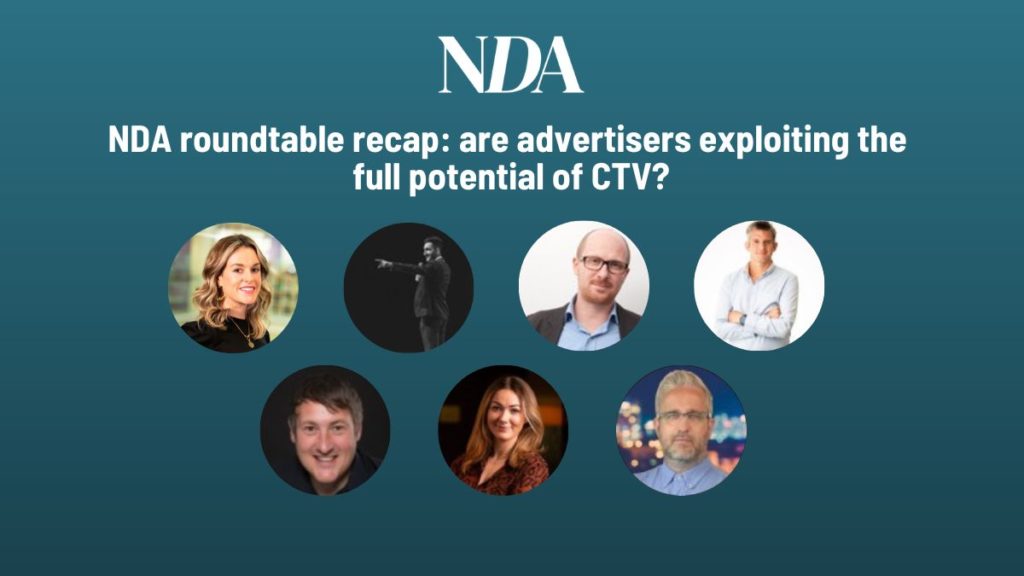Budgets are being diverted from traditional AV and digital campaigns into Connected TV (CTV), but are agencies and broadcasters ready to deliver on those brand investments? Are brands exploring the unique creative potential of CTV? What will be the impact of Netflix’s entry into the CTV ad market?
These were among the questions posed recently to a panel of senior TV and ad industry experts at a roundtable discussion hosted by New Digital Age (NDA). Justin Pearse, editor of NDA, chaired the conversation, and was joined by: Rhys McLachlan, Director of Advanced Advertising at ITV; Amy Tocock, Director of Investment Strategy at PHD UK; Gavin Stirrat, CEO, Adimo; Charlie Glyn, Ad Technology Leader, Channel 4 Sales; Andy Jones, Head of UK Sales, Samsung Ads; Rob Blake, Country Manager UK, Channel Factory; and Alexis Wrightson, Lead Product Specialist at Quantcast.
Rob Blake of Chanel Factory, believes that, in some ways, the increasing popularity of CTV with viewers is encouraging a return to pre-digital values among marketers: “At the beginning of any YouTube campaign we run, we work with our clients to clarify and agree on the real goals and KPIs of the campaign. I feel that we’re going back to the base level of media planning, which I find really exciting and encouraging. With the growth of programmatic buying, the traditional skill of media planning got sidelined for a while and everyone was just shooting for better performance and lower CPAs. I think the growth of the CTV marketplace is encouraging us to get back to basics in terms of understanding the value of planning and great creative working in unison.”
Creativity put to the test
Gavin Stirrat of Adimo agreed that while CTV represents an exciting new channel for advertisers to explore, the role of creativity remains crucially important in delivering the desired outcome of any campaign. He said: “We recently ran a couple of wine campaigns on CTV. One was fairly vanilla with the stereotypical man and women drinking wine on the beach. The second was celebrity-led and a bit edgier and that drove 4 times more responses than the other one. So the creativity of the ad itself, I think, still plays a big part in terms of driving the right reaction from the consumer.
“When we work with our clients to make ads shoppable we try to create that connection that happens when you’re at a till in a supermarket, see something and decide to buy it in the moment. TV and video is one of the few media where you can create that ‘in the moment’ connection.”
Commenting on the post-pandemic revival of QR codes as a marketing tool, Alexis Wrightson of Quantcast spoke of the need for advertisers to test and experiment in environments like CTV. He said: “We worked on a CTV campaign recently that included a QR code and, after the first couple of weeks, the client had received very few responses and were beginning to think it was pointless. They then increased the frequency cap on the ad and found that engagement went up significantly. Many more people scanned the QR code after seeing the ad three or four times rather than just once or twice.”
Conversations and collaborations
Are traditional silos between the skills of agency AV teams and digital/programmatic teams still impacting the growth of CTV ad revenues?
Andy Jones of Samsung Ads believes the situation is improving:“When we first launched, we were getting much more traction among the agency digital teams. By comparison, the AV teams didn’t want to know. They told us that their world was already complex enough! Now that the silos in agencies are beginning to break down a little, supporting those AV departments with CTV planning expertise and strategic vision is absolutely vital.
“There’s still a real difference between the capabilities of different agency groups, which means that my team needs to be really flexible. We need to be able to speak ‘digital’ language, ‘TV’ language, and ‘planning’ language, depending on who we’re talking to.”
Charlie Glyn, Ad Technology Leader at Channel 4 Sales pointed to the value of data partnerships in helping AV teams understand the potential of CTV ad targeting: “We’ve just finalised our own partnership with Nectar. By using that shopper data in combination with the registered C4 user data in a privacy-compliant way, we can close the loop on ads with actions later on. That’s something that we’ve found really resonates with AV teams and makes them take more notice of what CTV can deliver.”
The Netflix factor
As we approach 2023, much of the media commentary around CTV is focusing on the market entry of players included Disney+ and Netflix with their own ad-supported subscription services.
PHD’s Amy Tocock predicts an initial flurry of interest, before the dust settles and marketers once again begin to ask the usual questions around transparency, reach and measurement: “It’s going to be very interesting to see what happens with Netflix in the UK. There’s often a presumption among global companies that if something plays well in the US, it will work well here, but that’s not true. The UK TV marketplace is unique in so many ways and that makes it very unpredictable.”
Rhys McLachlan of ITV believes the media attention being lavished on Netflix is unwarranted and that, even if successful, Netflix’s subscriber AVOD option will soon be regarded as just another CTV broadcast channel.
McLachlan said: “As a broadcaster, I’m actually disappointed by the commentary that Netflix entering the ad marketplace will suddenly spark some kind of creative renaissance. The UK’s commercial broadcasters have weekly reach that is considerably greater than Netflix in this market and we’ve been working with brands and agencies to create great advertising for the past 50 years.
“At ITV, by the end of September 2022, we ran 400 more CTV-only campaigns than we did in the entirety of 2021. In many ways, the 30-second ad format is in better health than ever. We’re seeing more digital budgets, which were previously allocated to Google and YouTube, starting to come our way now. More recently, we’ve been picking up innovation budgets and discretionary budgets as well. There’s a lot of interest in the use of data and the use of tech to enhance and amplify the impacts of advertising. The CTV canvas is a rich one and there’s potentially so much more that advertisers could be doing.”
Read the first part of this roundtable discussion here.










